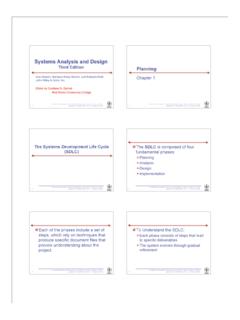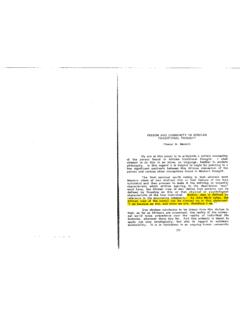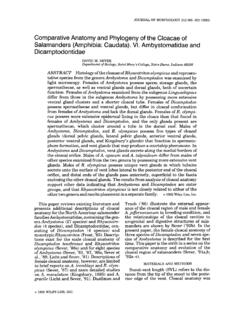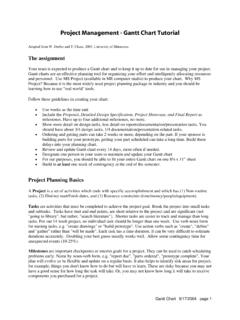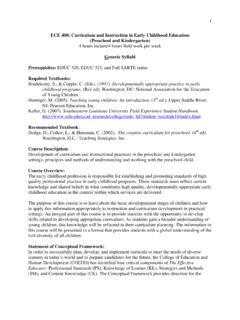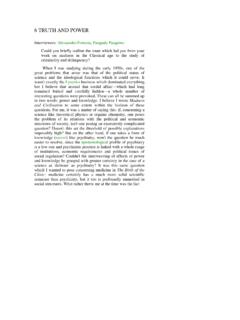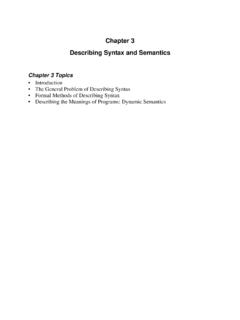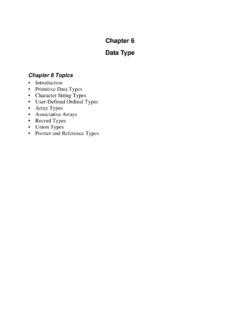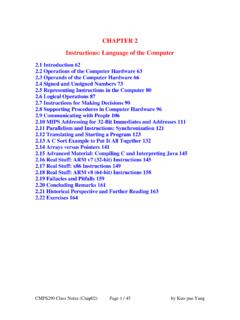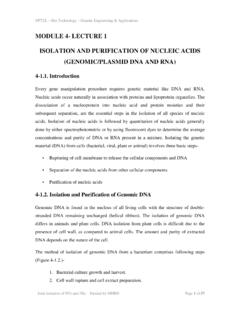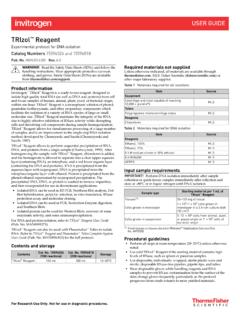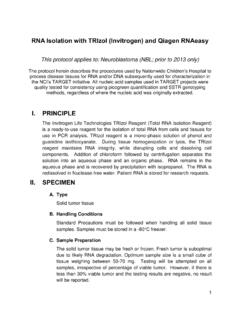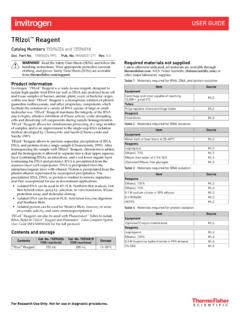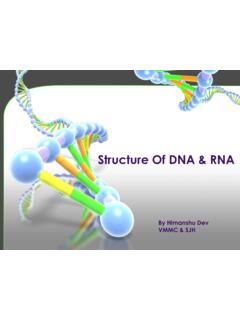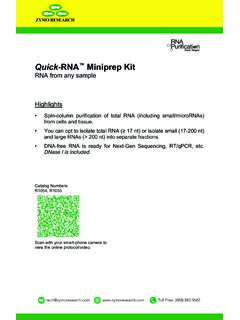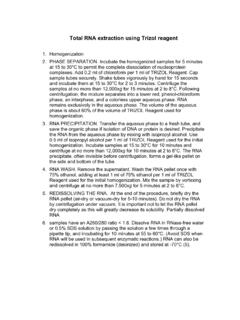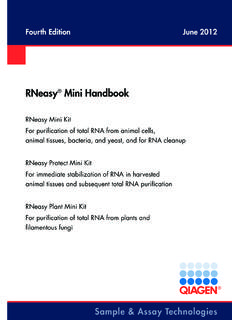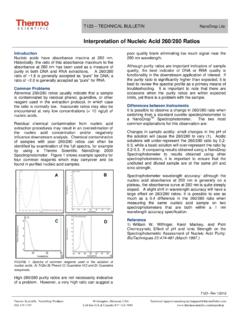Transcription of Experiment 2 Plasmid DNA Isolation, Restriction Digestion ...
1 5 Experiment 2 Plasmid dna isolation , Restriction Digestion and Gel Electrophoresis Plasmid dna isolation introduction: The application of molecular biology techniques to the analysis of complex genomes depends on the ability to prepare pure Plasmid DNA. Most Plasmid dna isolation techniques come in two flavors, simple - low quality DNA preparations and more complex, time-consuming high quality DNA preparations. For many DNA manipulations such as Restriction enzyme analysis, subcloning and agarose gel electrophoresis, the simple methods are sufficient. The high quality preparations are required for most DNA sequencing, PCR manipulations, transformation and other techniques.
2 The alkaline lysis preparation is the most commonly used method for isolating small amounts of Plasmid DNA, often called minipreps. This method uses SDS as a weak detergent to denature the cells in the presence of NaOH, which acts to hydrolyze the cell wall and other cellular molecules. The high pH is neutralized by the addition of potassium acetate. The potassium has an additional effect on the sample. Potassium ions interact with the SDS making the detergent insoluble. The SDS will easily precipitate and can be separated by centrifugation. In doing so the insoluble SDS traps the larger genomic DNA and removes it from the supernatant. This leaves the Plasmid DNA and RNA in solution.
3 The RNA is often removed by Digestion with the addition of RNaseA. This leaves only proteins, carbohydrates and RNA nucleoside monomers in solution. A primary alcohol, such as ethanol or propanol is used to precipitate the DNA. This is accomplished by the reordering of water, making the DNA aggregate and become insoluble. The result is a somewhat pure pellet of DNA that can be resuspended in a mildly buffered solution or water. Newer and more popular methods now exists that take advantage of the differences in physical properties of Plasmid DNA and the contaminants found in the alkaline lysis method. Recently, a diatomaceous earth-based method was used to isolate the Plasmid from cell lysate using the alkaline lysis method.
4 This is also called a siliga gel method. For this treatment the DNA pellet is resuspended in RNaseA to remove the RNA by Digestion . This is necessary because the RNA will compete with DNA for binding to the diatomaceous earth. After RNaseA treatment, the DNA containing supernatant is bound to the diatomaceous earth in a chaotropic buffer, often guanadine chloride or urea. The chaotropic buffer will force the silica (diatomaceous earth) to interact hydrophobically with the DNA. Purification using silica-technology is based on a simple bind-wash-elute procedure. Nucleic acids are adsorbed to the silica-gel membrane in the presence of high concentrations of chaotropic salts, which remove water from hydrated molecules in solution.
5 Polysaccharides and proteins do not adsorb and are removed. After a wash step, pure nucleic acids are eluted under low-salt conditions in small volumes, ready for immediate use without further concentration. The diatomaceous earth is centrifuged and contaminants are left behind in the supernatant. DNA is eluted during incubation at 65oC and then removed from the particles. Restriction Digestion Analysis: Restriction Digestion is the process of cutting DNA molecules into smaller pieces with special enzymes called Restriction Endonucleases (sometimes just called Restriction Enzymes or RE's). These special enzymes recognize specific sequences in the DNA molecule (for example GATATC) wherever that sequence occurs in the DNA.
6 Restriction Digests begin by mixing the DNA and the RE, but it's unfortunately not quite as simple as that. Restriction Enzymes are delicate and need to be treated carefully. Because enzymes are proteins and proteins denature as the temperature is increased, RE's are always stored in a freezer until they are used. In fact, all of the ingredients in a Restriction Digest are kept on ice until it's time for the reaction to begin. The actual reaction conditions vary from one enzyme to the next, and include temperature, NaCl and/or MgCl2 concentration, pH, etc. All of these variables except temperature are optimized by 6mixing the enzyme and DNA with a buffer specific for the enzyme of choice.
7 Once all the ingredients are mixed in the reaction tube, the tube is incubated at the Restriction Enzyme's optimal temperature for 1 hour or longer. Once the Restriction Digest is completed, agarose gel electrophoresis is performed to separate the digest fragments by size and visualize the fragments and perhaps purify them for further experiments. Agarose Gel Electrophoresis Mobility of a molecule under the influence of an electric field "is determined by its charge, its formula weight, the pore size of the matrix material and the strength of the electric field". This holds true for the electrophoresis of DNA in agarose gels. Because DNA and RNA have constant anionic charge/mass ratios (one phosphate for every nucleotide linkage) they travel through the gel at a constant speed in response to an electric current.
8 The DNA polymers of various sizes (sometimes called DNA fragments) are separated by the molecular sieving action of the pores in the agarose gel. Agarose is used as the matrix in DNA electrophoresis because it can be used to form much larger pores than polyacrylamide. The lower the percentage of agarose or polyacrylamide, the larger the pores. DNA migrates differently depending on whether it is circular or linear. Linear DNA migrates through the agarose pores in an end-on-end fashion and snakes its way through the pores. Circular supercoiled DNA is more compact and migrates through the pores more easily. Linear DNA almost always migrates more slowly than circular supercoiled DNA.
9 There are primarily two types of circular DNA, closed and nicked. Closed circular DNA has all of its nucleic acids linked with phosphodiester bonds and is supercoiled. Nicked circular DNA has at least one broken phosphodiester linkage. Nicked DNA is sometimes also called relaxed DNA because some of the tension present in covalently closed and superhelically twisted DNA has been released. Closed circular DNA can be supercoiled. A single nick in one strand is sufficient to release the tension caused by all degrees of supercoiling. Even though all of these DNA forms have the same number of nucleotides and the same formula weight, they migrate differently during gel electrophoresis.
10 You should also be aware that they do not necessarily migrate in the order presented in the figure above. Depending on conditions the linear form may be faster than supercoiled DNA or slower than nicked DNA. Detection of Nucleic Acids in Gels: The most popular method for the visualization of double stranded DNA (or RNA) in agarose gels is the fluorescent dye ethidium bromide (see below). This dye is a planar molecule and intercalates between the stacked base pairs of DNA. When the dye becomes fixed in its position and enters the hydrophobic interior of the DNA, it becomes more fluorescent than free dye in solution. The dye absorbs UV light at 300 to 360 nm and emits light at 590 nm in the red-orange region of the visible spectrum.
